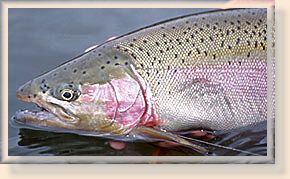The High Desert Lakes of British Columbia
Part Three

By Gordon Honey
Equipment Selection
Appropriate rod and line sizes, rod lengths and line types may vary, dependent upon
techniques, weather conditions and water depth. It is not uncommon for an
experienced, stillwater angler to carry four rods, completely setup for a day on
the water. A much simpler method is to have two rods and reels set up, carrying
various line types on spare spools.
Reels, need only a simply drag system, an exposed rim and the line capacity
to carry at least 100 yds. of backing.
Line types could be priorized as follows: floating; intermediate; full sink in rates of
#1; #2; #3 and a #4 for August.
Selected rod and line weights, become personal preferences and may vary from
5 to 8 weights. If only one all round weight was to be decided upon, a 6 weight
in two lengths, and 8 ft. and a 9 ft. would be perfect. They can handle the larger
fish, and can drive long casts into the wind when necessary.
Long casts, 60 to 80 ft., while not always essential, allow for more fishing time,
as each retrieve is made. If you feel intimidated by this - don't be, practice
before going on the water. A great deal of time can be spent sitting down when fly
fishing from a boat, both for comfort, and at times to keep a low profile, it would
therefore, be wise to practice casting from a sitting position as well.
Key Time Periods & Relative Food Sources
Immediately following ice off, prior to spring turn over, trout key on staple and
constant food sources - leeches, fresh water shrimp (scud) and chironomid (midges)
larvae, commonly called bloodworms. May and early June is the primary chironomid
period as trout gorge themselves on the pupae as they rise slowly to the surface, in
a vertical migration. This is an exciting time for the knowledgeable anglers, fishing
with floating lines and, dependent on the water depth, leaders of between 15 and 25 ft.
in length are common. This type of angling requires long casts, and infinite patience as
the retrive must be slow, slow and slower still as the chironomids with no ability to swim,
simply rise to the surface as they writhe and twist. Your floating line becomes your
strike indicator, so constant, hawk-like attention must be paid as even the smallest movement
or twitch can be a take.
June and early July is a busy time for both Mother Nature and the fly fisher as various
major hatches occur, sedges (caddis), mayflies (Callibaetis), damsel flies and
dragonflies both the Darner (free swimmer) and the Gomphus (bottom walker)
create the trout's menu! Being a keen observer is the key to success in any
situation.
Late July and most of August become the most difficult, technical fly fishing of the entire
season. Summer temperatures rise, and trout seek the cooler water of the thermocline,
fly fisher's must adapt in different ways, either maintaining the use of floating lines and
dry flies, while pursuing the smaller trout of the higher elevations, or patiently, probing
the deeps with various sinking lines; for larger fish, imitating dragonflies, shrimp (scuds)
and leech patterns. Changing to floating lines and as the evening cools and the trout
move to the shallows to forage on the shoals. It is not unusual, when under the cover
of dusk then darkness, nocturnal sedge's (caddis); leviathan's named locally as
Traveler's, perform their wild skating dance upon the serene moonlight waters;
stimulating a feeding frenzy, accompanied by slashing rises; that live forever in the
memory of anglers fortunate enough to experience such an evening!
September and October are heralded by flights of migrating water fowl, the crisp
tonic of fall air, cool mornings, warm afternoons and active trout! This is the time of
large fish as they prepare for the long winter months ahead. Frosts continue to thin
the stand-up weeds of the shoals allowing room for the wide shouldered; nickle plated,
slabs of fall to move and feed freely on the shoals. Life for the fly fisher becomes
energized, as the trout's feeding preferences become simpler as they return to the
staples once more. Bloodworms, leeches, dragons, scuds, water boatmen and some
chironomid hatches combine to create a tremendous fishery.
As November approaches, and temperatures continue to fall, the increase of morning
shore ice heralds the approach of winter. Life below the surface slows, light begins
to fade, as the curtain of ice is drawn relentlessly over the lake surface, our season
of stillwater has ended. ~ Gordon Honey
Credits: From Angling in the Shadows of the Rockies
by Jeff Mironuck. We thank
Frank Amato Publications, Inc. for use permission!
Our Man In Canada Archives
|

